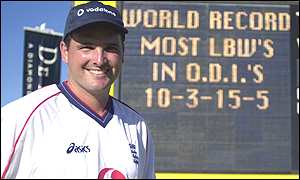
A gradual but inevitable descent into cricket-based loathing and bile.
Whatever Happened To The Unlikely Lads? #6: Mark Ealham
The search for the new Ian Botham has been a long and almost entirely fruitless one for England. For twenty years the unquenchable thirst for a heroic all-rounder has seen any number of players tried. With the notable exception of Andrew Flintoff (particularly the 2004-2006 version) none have ever succeeded. One of the earlier attempts is our latest Unlikely Lad: the cult hero that is Mark Ealham.
#6: Mark Alan Ealham
There are a number of players who were simply years ahead of their time, especially insofar as the different formats of the game are concerned. We’re particularly thinking of those big hitters who might have excelled in modern ODIs or Twenty20 players who played before the format was invented. In our view, alongside Dermot Reeve, Mark Ealham is a perfect example of the latter. A strapping lad (think Austin, Ian), he was genuinely decent with both bat and ball, as his first class averages testify: 31.96 with the bat and 27.93 with the ball.
Ealham the batsman was a powerful hitter with a penchant for rapid hundreds (such as from 44 balls against Derbyshire in 1995, still the fastest hundred in the history of the 40-over game); Ealham the bowler was a line and length merchant, bowling wicket to wicket at an annoying medium-fast pace.
After making his county debut for Kent in 1989, Ealham (the son of Kent legend Alan) eventually forced his way into the England reckoning in 1996. England were due to take on India in that summer’s Texaco Trophy. Following yet another disastrous World Cup campaign (where they lost every single match against Test-playing nations) England chose to take a new route, going all-rounder crazy. Ealham was called into the side as one of three debutants, batting at number eight. This was behind Ronnie Irani but ahead of Chris Lewis and Dominic Cork. We weren’t joking about the all-rounders.
England made 291 from their 50 overs with Ealham contributing a swashbuckling 40 from 34 balls, with three fours and two sixes. India collapsed to 96/5 in reply yet still escaped thanks to rain – this being pre-Duckworth/Lewis. There was a reserve day but this being England in May, it was washed out.
The second game saw India skittled out for 158 and England strolled to victory, with Ealham bowling only six overs and not being required to bat. And of course, this being England in the 90s, Ealham was promptly dropped for the third match. England went for seven batsmen and only four bowlers, using Neil Smith and Graham Thorpe as a fifth. Back in those days meetings between the selectors consisted mainly of gin-drinking competitions.
Regardless, Ealham had done enough to earn a place in the Test squad and eventually the starting XI, debuting in the third match of the summer, against India. Both sides traded 500+ scores in the first innings, with Ealham making 51 from the lofty heights of number six in the order. He then picked up 4/21 in the second innings (for match figures of 6/111) as the game petered out into a draw.
Pakistan were the second visitors of that summer. In the opening Test of the series Ealham had a distinctly less successful time of it, taking a single wicket and making 25 and 5 with the bat as England lost by 164 runs. This match also featured two more Unlikely Lads: Graeme Hick and Ian Salisbury. All three were dropped for the second Test.
Ealham wasn’t selected for England’s tours of Zimbabwe and New Zealand the following winter but was surprisingly brought back into the Test side for the following summer’s opening Ashes Test. He wasn’t required to bowl in the first innings – Australia were skittled for just 118 – but made a valuable 53* with the bat and took three quick wickets to wrap up the Aussie tail as England romped to a famous nine-wicket win.
Sadly, that was as good as it got, both for Ealham and England. In the following three games he took just five more wickets and scored just 52 more runs as Australia inflicted two heavy defeats. For game four England turned instead to the Brothers Hollioake. It made no difference, as Australia won by 264 runs to retain the Ashes.
Oddly enough, Ealham was again recalled the following summer, playing two matches against South Africa. Two wickets and just 24 runs weren’t enough and following a ten-wicket defeat in the second Test Ealham was once again cast aside, this time never to return to Test cricket.
Ealham had a slightly more successful run in England’s ODI side, playing 64 matches. For such a capable batsman, his batting record was woeful – an average of 17.46 and a top score of just 45 – but he had his moments with the ball. In 2000 he took 5/15 from ten overs against Zimbabwe, all of them LBW.
He was also a key part of England’s 1997 Champions Trophy win in Sharjah, conceding just 26 runs from his ten overs in the final and taking the key wicket of Brian Lara,with a little help from Alec Stewart:
And yet another new Ian Botham ended up on the England scrapheap by 2001. International T20 cricket didn’t start for another four years. While we’ll never know for sure, it’s hard to believe that Ealham wouldn’t have been able to make a real impact in that format of the game. He could even have been England’s first IPL star – a strike rate of more than 155 in domestic T20 is nothing to be sniffed at. Instead he’ll just be remembered as a fat guy who did well in the county game and slightly better than Ronnie Irani at international level, a cardboard epitaph for such a talented player. We’re still not taking down our posters though.




2 Comments
Post a Comment
1
Nichael Bluth
11 Mar 2012 02:19
I’m quite looking forward to doing the WHTTUL piece on Ronnie Irani someday.
2
Matt H
10 Mar 2012 17:26
It was so typical of selection policy in the 90s that he had a very good game, followed by a pretty poor game and was thus dropped. Mind you, in a better world with more consistent selection policy, the likes of him, Irani and other substandard all-rounders wouldn’t have been picked (for the Test team) in the first place.